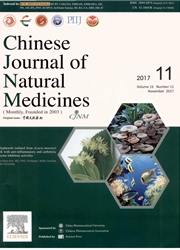

 中文摘要:
中文摘要:
The present study aimed at developing a natural compound with anti-allergic effect and stability under latex glove manufacturing conditions and investigating whether its anti-allergic effect is maintained after its addition into the latex. The effects of nine natural compounds on growth of the RBL-2H3 cells and mouse primary spleen lymphocytes were determined using MTT assay. The compounds included glycyrrhizin, osthole, tetrandrine, tea polyphenol, catechin, arctigenin, oleanolic acid, baicalin and oxymatrine. An ELISA assay was used for the in vitro anti-type I/IV allergy screening; in this process β-hexosaminidase, histamine, and IL-4 released from RBL-2H3 cell lines and IFN-γ and IL-2 released from mouse primary spleen lymphocytes were taken as screening indices. The physical stability of eight natural compounds and the dissolubility of arctigenin, selected based on the in vitro pharnacodynamaic screening and the stability evaluation, were detected by HPLC. The in vivo pharmacodynamic confirmation of arctigenin and final latex product was evaluated with a passive cutaneous anaphylaxis(PCA) model and an allergen-specific skin response model. Nine natural compounds showed minor growth inhibition on RBL-2H3 cells and mouse primary spleen lymphocytes. Baicalin and arctigenin had the best anti-type I and IV allergic effects among the natural compounds based on the in vitro pharmacodynamic screening. Arctigenin and catechin had the best physical stability under different manufacturing conditions. Arctigenin was the selected for further evaluation and proven to have anti-type I and IV allergic effects in vivo in a dose-dependent manner. The final product of the arctigenin-containing latex glove had anti-type I and IV allergic effects in vivo which were mainly attributed to arctigenin as proved from the dissolubility results. Arctigenin showed anti-type I and IV allergic effects in vitro and in vivo, with a good stability under latex glove manufacturing conditions, and a persistent anti-allergic effect after being
 英文摘要:
英文摘要:
The present study aimed at developing a natural compound with anti-allergic effect and stability under latex glove manufacturing conditions and investigating whether its anti-allergic effect is maintained after its addition into the latex. The effects of nine natural compounds on growth of the RBL-2H3 cells and mouse primary spleen lymphocytes were determined using MTT assay. The compounds included glycyrrhizin, osthole, tetrandrine, tea polyphenol, catechin, arctigenin, oleanolic acid, baicalin and oxymatrine. An ELISA assay was used for the in vitro anti-type I/IV allergy screening; in this process/~-hexosaminidase, histamine, and IL-4 released from RBL-2H3 cell lines and IFN-7 and IL-2 released from mouse primary spleen lymphocytes were taken as screening indices. The physical stability of eight natural compounds and the dissolubility of arctigenin, selected based on the in vitro phamacodynamaic screening and the stability evaluation, were detected by HPLC. The in vivo pharmacodynamic confirmation of arctigenin and final latex product was evaluated with a passive cutaneous anaphylaxis (PCA) model and an allergen-specific skin response model. Nine natural compounds showed minor growth inhibition on RBL-2H3 cells and mouse primary spleen lymphocytes. Baicalin and arctigenin had the best anti-type I and IV allergic effects among the natural compounds based on the in vitro pharmacodynamic screening. Arctigenin and catechin had the best physical stability under different manufacturing conditions. Arctigenin was the selected for further evaluation and proven to have anti-type I and IV allergic effects in vivo in a dose-dependent manner. The final product of the arctigenin-containing latex glove had anti-type I and IV allergic effects in vivo which were mainly attributed to arctigenin as proved from the dissolubility results. Arctigenin showed anti-type I and 1V allergic effects in vitro and in vivo, with a good stability under latex glove manufacturing conditions, and a persistent anti-allergic effect after bein
 同期刊论文项目
同期刊论文项目
 同项目期刊论文
同项目期刊论文
 Differential involvement of 5-HT1A and 5-HT1B/1D receptors in human interferon-alpha-induced immobil
Differential involvement of 5-HT1A and 5-HT1B/1D receptors in human interferon-alpha-induced immobil 5-HT1A receptor and apoptosis contribute to interferon-alpha-induced depressive behavior in the mice
5-HT1A receptor and apoptosis contribute to interferon-alpha-induced depressive behavior in the mice 期刊信息
期刊信息
